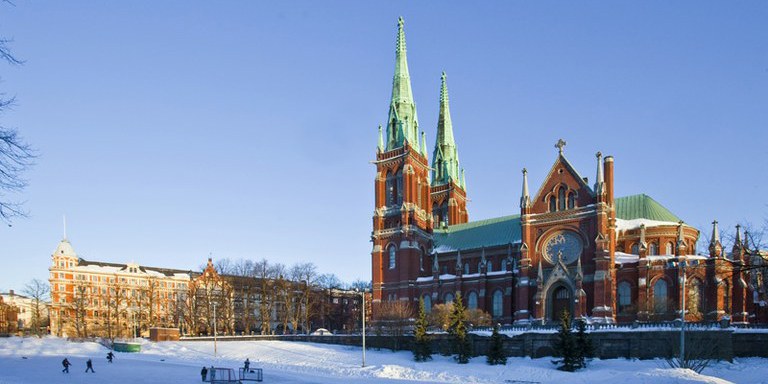St. John's Church

St. John's Church was completed in 1891 on top of the Punanotko hill, on the outskirts of the city at the time. The church was designed by Adolf Emil Melander from Stockholm. St. John's Church was initially called Uusi kirkko (New church). It came in useful, because the Helsinki residents could not all fit into the Old Church or St. Nicholas Church, the current Cathedral. The new church, built on top of the hill where midsummer bonfires were held, became a shrine named after John the Baptist.
The cathedral-style St. John's Church is located in southern Helsinki, on the boundary of the Kaartinkaupunki and Punavuori districts. The church represents the neogothic style. The floor plan is cross-shaped. The exterior is characterised by a massive granite footing and red brick brickwork. Two 74-metre towers rise at the north-eastern end, above the main entrance. Next to the main entrance is a statue by sculptor, Kari Juva, of John the Baptist, from 2003.
The building is 59 metres long and the inside length of the nave is 42 metres. The tall arched windows, rose windows in the gables and numerous small windows with their decorative and coloured panes create impressive lighting effects. Circular rose windows, painted with transparent colours on pieces of glass, and often of a mosaic style, are found in the tower side gables of a Gothic cathedral. The rose is the symbol of Virgin Mary.
Numerous chandeliers and sconces also light up the church. The light fixtures, window panes and altar decorations are from Stockholm. The four brass wall brackets closest to the altar carry the symbols of the four evangelists. The other wall brackets are decorated with dragons.
The benches, pulpit, altar and baptism table of the church were designed by the architect of the church. The ends of the benches, the pulpit and the altar repeat the trifoliate clover motif, inherited from the Celts, and a very common Holy Trinity motif in Gothic imagery.
The altarpiece drafting contest was won by artist, Albert Edelfelt, with his subject, Bethlehem. However, it was never implemented because of disputes between the artist and the architect. When an altarpiece was finally received in 1932, it was Taivaallinen näky (Heavenly sight) by artist Eero Järnefelt, which depicted the conversion of Saul. Before Järnefelt’s last great work of was completed, a light cloth painted blue stood in place of the altarpiece.
At the highest point of the altarpiece is the leader of the heavenly host, the archangel Michael, a little lower, the Lamb of God, symbolising Jesus, and on the sides, the apostles Peter and Paul sculpted from wood. Below the altar can be found the letters alpha and omega, signifying the beginning and the end, and the Christ monogram. Above the altar is a small cabinet, where blessed communion wafers or relics are kept, in accordance with catholic requirements.
It also took a long time to obtain the bells. In autumn 1932, the electrically operating bells were lifted up to the north tower. They play the first three notes of Te Deum, Cis, E and Fis. The bells were manufactured by Tampere Lokomo Oy.
St. John's Church has a font made of hammered copper, commissioned from sculptor, Emil Cededcreutz, in 1940. Its stand was made at the artistic forge of Antti Hakkarainen. The mass cassock with a lamb theme is the handiwork of textile artist Hanna Loimaranta, from 1927.
The church textiles from different eras show the changes in the rituals and the adoption of liturgical colours. The textiles are decorated with different Christian symbols. The symbols include, for example, a lamb, a dove, an ear of corn, a bunch of grapes and grapevine, an equilateral triangle, three-leaf and four-leaf clover, and the character symbols IHS, the Hebrew abbreviation of Jehovah, the first and last letter of the Greek alphabet, alpha and omega, and the Christ monogram. New textiles have, for example, five loaves of bread and two fish, a crown of thorns, a three-leaf clover and different cross models such as the Jerusalem cross, Greek cross, quadrate cross and circular cross.
The old mass cassocks were only red, black and white. Gold and silver have since been added to cassock decoration. The new textiles made after the 1950s display all five colours of the ecclesiastical year.
The original communion requisites, designed by Hjalmar Fagerroos, follow the neo-gothic style. They repeat the Christ monogram, cross and palm branch, crown of thorns and three- and four-leaf clover. At the turn of the millennium, the parishioners donated communion cups made by silversmith, Henrik Kihlman, to the church.
It is possible to spread a matrimonial rug by textile artist, Irma Kukkaisjärvi, under the feet of the bride and bridegroom.
The 66-stop organ was made by German organ factory, E.F. Walcker & Co. in 1891. The organ was renewed in 1956 to be 74-stop. The renovation completed in 2006 aspired to the tone planned for it by the first organist of the church, Oskar Merikanto. The acoustics are good in the church, and it is a popular venue for concerts. The church also has a grand piano.
Over the years, several repairs and changes have been made to St. John's Church. The wall surfaces of the church were originally plastered in a greenish grey colour. The top parts of the walls and arches had decorative patterns. During later renovations, the walls were covered with a solid light colour. In the latest renovation, some of the old decorative painting layer has been revealed on the wall of the public gallery. Just before the centennial of the church, its cellar was partly taken into use.
Counting the seats, St. John's Church, part of Johannes församling, is the biggest stone church in Finland. It seats 2,600 people. It has become familiar to all of Finland from the popular TV series, Kotikatu.
Celebration at the church
Members of the church can organise a baptism, a wedding or a funeral free of charge in the church.






